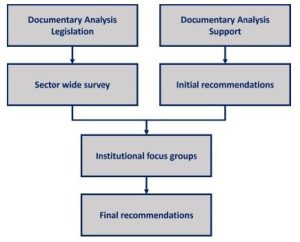By Dr Iro Ntonia, Centre for Higher Education Research and Scholarship
Inclusivity in teaching and learning within the HE context is a nuanced and layered concept. It is commonplace for HEIs to rely on toolkits and recommendation checklists, however oftentimes the true meaning of inclusive practice, and the complexities of implementing an authentically inclusive and equitable approach are often lost in translation from checklist to practice. In a research project led by Katie Stripe (Senior Learning Designer, Education Office), we reflected on our own practice and explored alongside practitioners what the perceived barriers for implementing an inclusive teaching and learning approach may be. We recently published our findings in the Journal of Learning Development in Higher Education (DOI: https://doi.org/10.47408/jldhe.vi28.1034 ) and are currently exploring avenues for disseminating our conclusions.
The story so far:
Our approach was mainly guided by our reflections and observations on how HEIs generally attempt to approach the topic of inclusivity, undoubtedly with good intentions, but ultimately risking focusing on a rigid set of definitions on what inclusivity is, or producing resources that do not cover the whole range of attributes which may at times end up missing the mark. For example, Dalton et al (2019) write about inclusive education in South Africa, a country with a deep history of racial inequality, yet focus their inclusion strategies on disability. This is indicative of the wider literature which either focuses on one sub-group of the population, or on interventions for accessibility, with both approaches being inherently limited. Institutions are beholden to legislation, benchmarking schemes, staff and student unions, quality assurance process, and funding (e.g., Equality Act 2020, Higher Education and Research Act, 2017, Athena Swan, Race Equality Charter, The Office for Students, and the QAA). As such, they must find a balance that works for everyone, and which manifests across institutional levels by bridging potential gaps between policy and practice.
We were primarily interested in what institutions are practically able to do to promote inclusive education, and what barriers might be faced in the implementation of these practices. We combined documentary analysis of current UK legislation, review of a broad range of institutional inclusivity support documents, surveyed representatives from across the UK sector and conducted focus groups with Imperial staff from a range of teaching and/or supporting learning roles across College.

Fig.1: Data collection and analysis process
Based on their recurrence across multiple resources, the following themes emerged as ‘critical’ to the development of inclusive education: use of representative resources, variety of teaching and assessment, accessibility of content, reflection on identity/limits/biases, being cognisant of the impact of the hidden curriculum, and the opportunity to ask questions. Analysis of our data produced a set of 22 recommendations for inclusive practice, which we then further categorised depending on the immediacy of their need for implementation. You can access the full set of recommendations here.
The work we discuss in our paper is the beginning of a much wider implementation process, but we hope to have laid the groundwork for ours and other institutions to use these to start a conversation, and reflect on what is needed. We surmise that true and authentic inclusion will only come when we collectively critique the status quo, challenge what we find, and follow through with implementation.
We would love to continue the conversation about our work, so please get in touch!